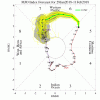accu35
Member
- Joined
- Jan 5, 2017
- Messages
- 8,756
- Reaction score
- 11,092
I agree, its just the gfs has been showing this Ice storm solution for a while now, i do believe there will be a storm location not sure but the signal is the there. Cmc is coming around as well, not there yet but close. I also notice the gfs is getting colder with each run as well.Yeah, but we need a stronger vort and better tilt in addition to the neutral tilt being further west. I'm also not counting any solutions as a real possibility until I see agreement between models and multiple consecutive runs agreeing.









